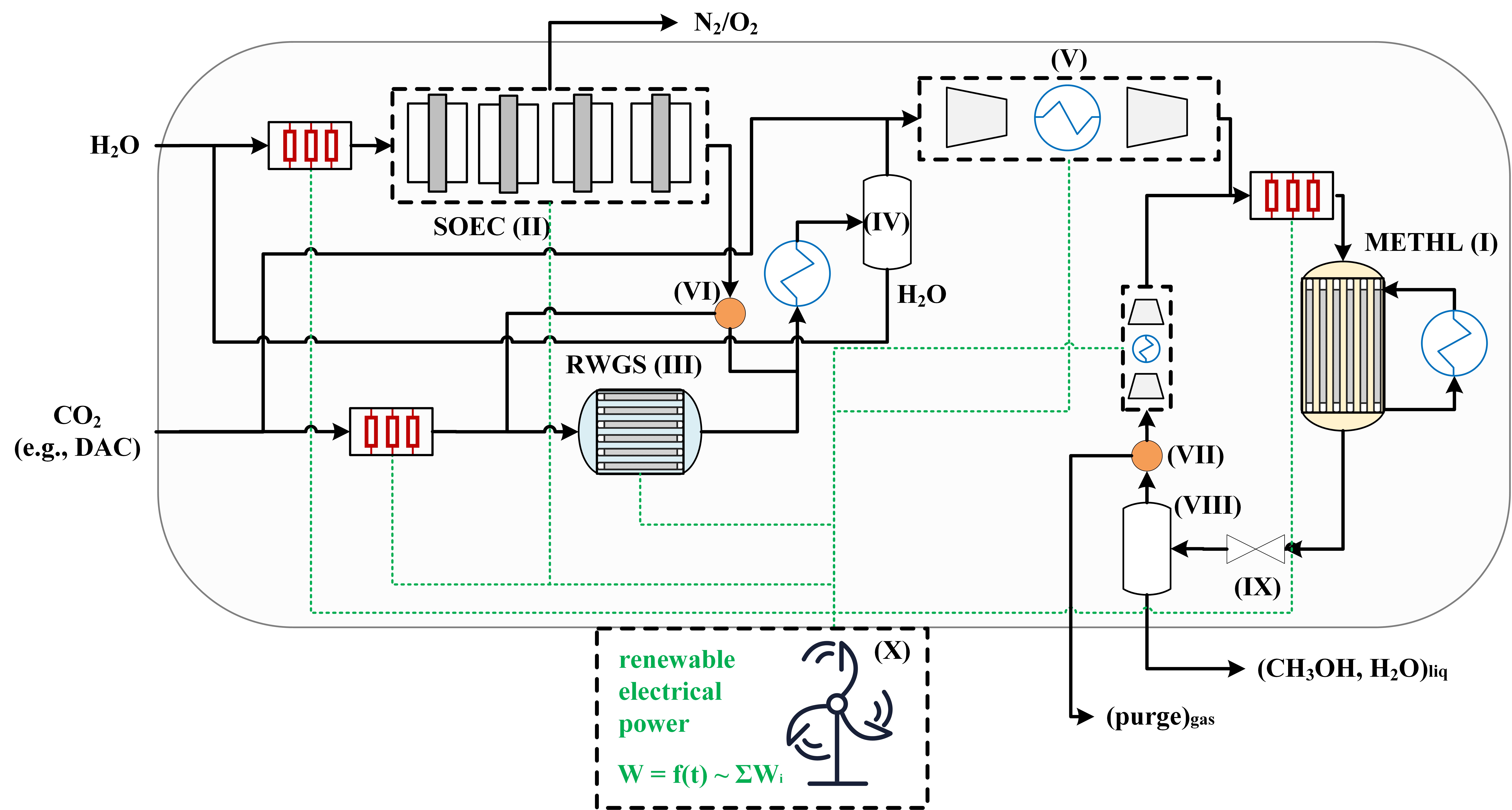(692a) Multiperiod Design Optimization of a Flexible Power-to-Methanol Process
AIChE Annual Meeting
2022
2022 Annual Meeting
Environmental Division
Design and Optimization of Integrated Energy Systems II
Friday, November 18, 2022 - 8:00am to 8:21am
- Introduction
Energy transition scenarios require the implementation of process solutions capable of facing the inherent intermittency of renewable utilities. Under the umbrella of Power-to-X technologies, methanol synthesis has received considerable attention in recent years. Methanol is stored in liquid state as a chemical energy carrier or platform chemical, which makes it easily transportable and an ideal candidate for the chemical utilization of renewable energy. While traditional processes for methanol synthesis consider syngas from fossil feedstock (e.g., via gasification of coal, partial oxidation, or steam reforming of natural gas), the CAMERE process feeds CO2 and H2, ideally coming from renewable sources. For the CAMERE process, an intermediate reverse water-gas shift (RWGS) reactor partly converts CO2 into CO before entering the methanol reactor to avoid possible thermodynamic limitations related to the direct hydrogenation of CO2. Clearly, CO2 and H2 constitute important starting materials for methanol in a renewable framework, as the former can be taken from a renewable carbon source (e.g., direct air capture, biogas) and the latter can be produced by water electrolysis, e.g., via high-temperature solid-oxide electrolysis (SOEC). Furthermore, it is relevant to stress the interest in the electrification of endothermic processes to enhance the use of renewable sources. Considering all these aspects, a methanol plant is proposed and optimized with respect to the electrical power supplied by, for instance, an in-house wind farm. The next sections introduce modeling aspects and the optimization setup. Finally, the outcomes of the study are reported.
- Modeling
The CAMERE process layout extended with a SOEC is reported in Fig. 1. The methanol reactor METHL (I), the core item within the plant, is described as a one-dimensional pseudo-homogeneous bundle reactor, where the coolant temperature is constant along the axis. The reactants are provided via a zero-dimensional SOEC (II) model, where a number of stacks generate a mixed stream of steam and H2. The carbon feedstock to METHL is supplied by a RWGS isothermal equilibrium step (III) as a mixture of CO and CO2, while H2O is condensed and removed (IV) prior to the train of adiabatic compressors with intermediate cooling (V). It is assumed that the catalyst for RWGS is highly selective towards CO, therefore no methane formation is accounted for. A first splitter (VI) directs the outlets from SOEC either to the train of compressors prior to the METHL or to the RWGS. CO2 can also bypass the RWGS reactor. A second splitter (VII) is assumed to dose the purge-to-recycle ratio after a flash separator (VIII) at the METHL outlets, modeled with the SRK equation of state. The recycle stream is recompressed via a series of adiabatic intercooled steps from the throttling (IX) pressure back to METHL feed. The light green lines starting from the renewable power dashed box (X) represent the electrical power supplied to electrical heaters (in red), SOEC and compressors. The wind farm is solely represented by the available power input W. Cooling heat exchangers are represented in light green.
- optimization setup
All modeling equations were embedded into a NLP optimization problem, where the total power W, supplied by the renewable source (X), is completely utilized within the process. Methanol yield and CO2 conversion were selected as optimization objectives. Constraints are set to the maximum temperature in the methanol reactor. Important decision variables are METHL and SOEC reactor dimensions, compressor discharge temperatures and pressures, cooling temperature of METHL and operating temperature of RWGS and SOEC. The first optimization problem is based on a single period, where a single period is defined as a fixed power supply Wi, to be completely utilized within the model boundary. The solution of the single period optimization represents a reference solution, which corresponds to the optimal plant setup at a given constant load. Beyond that, the subsequent multiperiod optimization assumed that a number of discrete electrical power loads (periods Wi, i ) are representative of the intermittent power supply from renewable sources. The resulting optimal plant design offers a compromise for a set of periods and additionally provides the corresponding optimal operating conditions.
- Conclusion and future works
Representative scenarios (set of periods ) describe the distribution of renewable power loads over time in a highly electrified process for the synthesis of methanol from CO2 and H2. The results make it possible to determine the plant design that can best cope with the different loads and to monitor the target deviation over all periods. In future work, the identified design will be a good starting point to establish suitable control strategies for dynamically moving between different load cases. Using the applied methodology will also help to identify flexible process designs for other chemical syntheses to be fed with intermittent renewable electricity.
